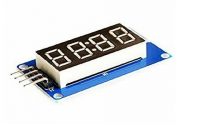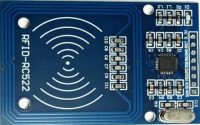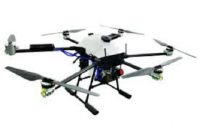Know all about Power Amplifiers for FM Transmitter
Amplifier circuits are used to form the basis of the various electronic system. These circuits are used to generate high power to drive some o/p device. The o/p power of the audio amplifier may be less than 1watt to 100watts. Amplifiers are classified into various types, they are power amplifiers, voltage amplifiers, current amplifiers, linear amplifiers, non-linear amplifiers, transconductance and transresistance amplifiers. In fact, these types of amplifiers are used for different applications.RF amplifiers are used in TXs to produce 1000KW of o/p power. Whereas DC amplifiers are used in electronic control systems to drive different types of actuators and motors. This article gives an overview of what is a power amplifier, power amplifiers for the FM transmitter.
What is a Power Amplifier?
Power amplifiers are classified into various types based on applications like an RF power amplifier, audio power amplifier, FM power amplifier, vacuum tube power amplifiers, stereo power amplifier, transistor and class-A, class-B, class-C, class-D and class AB power amplifiers. These kinds of amplifiers are used to amplify the o/p signals with weak i/p signals and also used for various specific applications. This article gives an overview of stereo power amplifier, FM amplifier, and working of power amplifier.
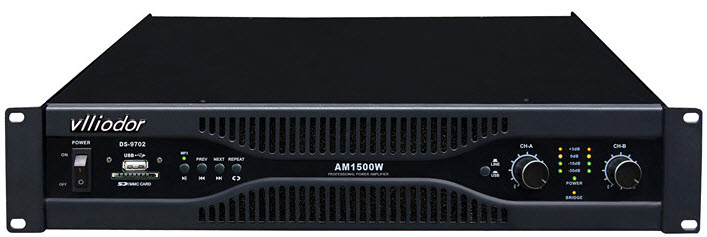
Power Amplifier Design and Working
The different power amplifier designs can be done with different ratings like 10Watt, 20Watt and 50Watt RMS values.But, basically the power amplifier needs to be capable of driving the preferred load. The circuit of the audio power amplifier consists of particular circuits to produce gains of voltage & current. Power amplifier consists of various stages like a voltage amplification, driver stage, and o/p stage as shown in the block diagram below.

First Stage: Voltage Amplifying Stage
In voltage amplifying stage, the i/p signal from the source is given to the electronic amplifier and it is in the range of millivolts to drive the following stages. Thus, in the first stage, mostly the amplified voltage is made strong to process the further stages. This purpose can be achieved by the class-A amplifiers and gain of the essential voltage can be attained by using two or more RC coupled class-A amplifiers.
Second Stage: Driver Stage
The driver stage can be treated as a middle stage, which views between the voltage amplification & o/p stages. The voltage amplifying stage alone is not sufficient to drive the o/p stage. Because, it has a low i/p impedance. Therefore, this second stage acts as a middle stage that can produce the gain of the current & gain of the sufficient power too.
Third Stage: Output Stage
The o/p stage is connected to the loudspeaker, third stage increases power gain additional and delivers to the o/p with less power loss. There are two outlines for this stage, namely push-pull arrangement or single transistor. But, arrangement of push-pull almost chosen compared to single transistor. The advantages of this mainly includes efficiency, high power o/p, DC current cancellation, cancellation of even-harmonics, and so on.
Circuit Diagram of Power Amplifier
The circuit diagram of the power amplifier is shown below.
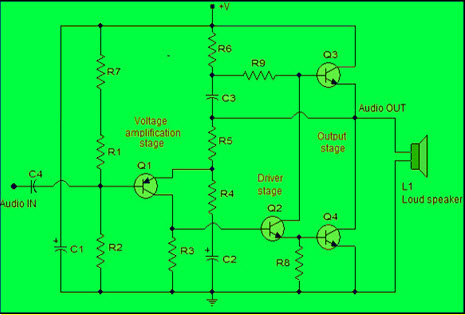
The circuit of the power amplifier includes three stages, namely voltage amplification, driver and o/p stages which we discussed in the above.The first stage can be formed with signal transistor, Q1 transistor and basic electrical and electronic components. The Q1 transistor is biased using R1 & R2 resistors, At the i/p signal, coupling capacitor C4 is used to block the DC components of the input signal .The current flowing to the biasing n/w can be restricted using R7 resistor & C1 is used as a filter capacitor. The collector terminal of the Q1 transistor provides the o/p of the first stage.
The second can be formed by Q2 transistor, power transistor & the base terminal of Q2 transistor is directly connected to the output of the first stage. The collector terminal of the Q2 transistor provides o/p of the driver stage.
The final stage can be formed using Q3 and Q4 power transistors, which are arranged in the push-pull arrangement. The collector terminal of the Q2 transistor & the base terminal of the Q3 transistor and the emitter of the Q2 transistor & base of the Q4 transistor is connected as shown in the above circuit. The output of the above circuit is drawn from the EB-junction of the o/p. The Eb-junction of the output transistors provides the whole o/p of the circuit.
There are different kinds of amplifier circuits, namely earphone amplifier circuit, hi-fi audio amplifier circuit, stereo power amplifier, and so on.
Thus, this is all about what is a power amplifier, power amplifier design, types of amplifiers. We hope that you have got a better understanding about this concept.Here is a question for you, what are the applications of different kinds of power amplifier circuits? Then, give your feedback by commenting through the comment section below.

